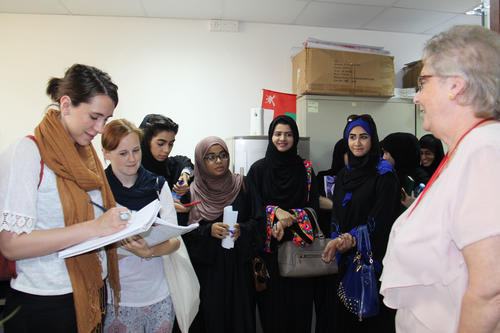Omani Media: Watching over a Young Media System with a Stern Eye
Letter from Oman! What is the situation with freedom of the press in the sultanate? Salome Bader found out.
Dec 01, 2015
One aspect that excited me about studying media in Oman was the fact that there is no comparison between freedom of the media here and in Germany. How this would affect my study program in Berlin was one of the things I asked myself before my semester abroad. To what extent would this be an issue at the university in the first place? Would censorship be discussed openly? Would it affect classroom instruction? And where do the instructors and students stand on the subject? To find out how the Omani media system is structured and compare it to other media systems, I took a course called “Omani Media.”
One of the main features of the Omani media system is that it is still a relatively recent development. Newspapers published in Oman and domestic radio broadcasting have only existed since the 1970s, when Sultan Qaboos opened the country. The media are still subject to stringent controls known as “editing” to this day. The issue was briefly brought up at the university, and the practice was praised as a good thing based on the argument that Omani media are not yet able to perform this task conscientiously on their own.
From what I have seen so far, the subject is more of a marginal issue at the university; there is not yet any open discussion about it. That’s different among my classmates and friends, who have given me a bit more information and told me some stories. On the subject of newspapers, for example, we were asked right away whether we noticed anything in particular and whether we thought the texts had been “edited” before publication. We could not help but agree, since when you read the articles, you notice right away that there is a stern eye monitoring them before they are published.
Visiting the Omani Media Firm Al Roya
We learned in the next sentence what happens if the publication standards are not met: In that case, publication of the newspaper is suspended for a week, or a journalist might spend a couple of days in jail. In private, this editing process was described as a problem, but even there, the need for controls was explained as being better for Omanis, since they do not know how to handle freedom, at least not yet.
After this advance information, we were naturally very eager to see what our trip to Al Roya, a successful private Omani media firm that publishes a daily newspaper, magazines, and books, would be like. While the newspaper is only published in Arabic, there are also magazines and books that are issued in English. The tour of the media company, which is very much like an editorial department in Germany inside, was interesting.
Unfortunately, two-thirds of the tour took place in Arabic, and these 20-minute Arabic presentations were then summarized for us in just three English sentences afterward. It would surely have been even more interesting if we had understood everything the journalists were telling us. Especially with regard to the challenges of publishing, more information would have been exciting. The English-language portion of the tour gave us a brief look at the Omani media world, and we hope to be able to further our understanding by the end of the semester.

